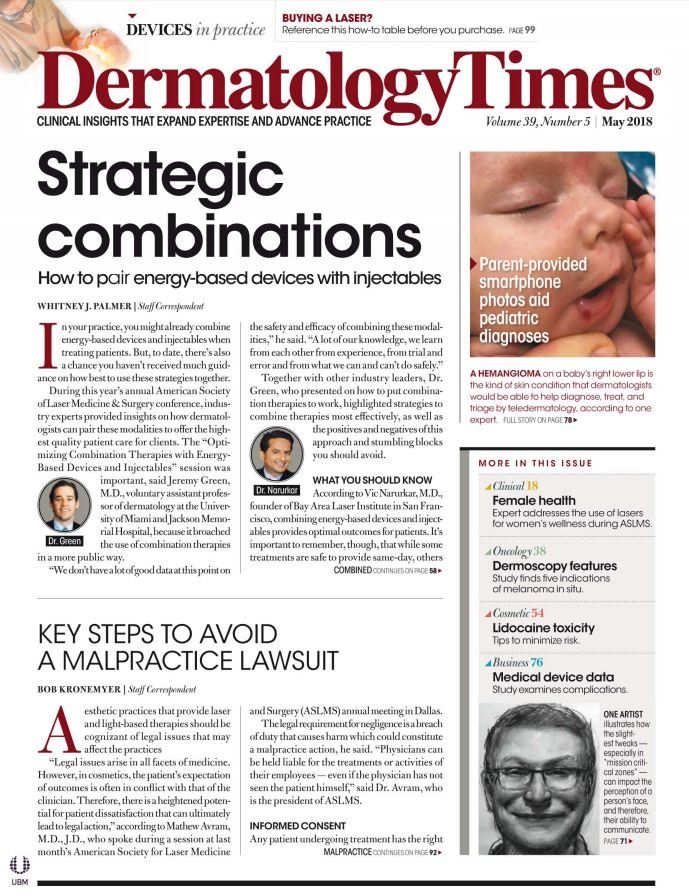- Case-Based Roundtable
- General Dermatology
- Eczema
- Chronic Hand Eczema
- Alopecia
- Aesthetics
- Vitiligo
- COVID-19
- Actinic Keratosis
- Precision Medicine and Biologics
- Rare Disease
- Wound Care
- Rosacea
- Psoriasis
- Psoriatic Arthritis
- Atopic Dermatitis
- Melasma
- NP and PA
- Skin Cancer
- Hidradenitis Suppurativa
- Drug Watch
- Pigmentary Disorders
- Acne
- Pediatric Dermatology
- Practice Management
- Prurigo Nodularis
- Buy-and-Bill
Publication
Article
Dermatology Times
Minimizing the risk of lidocaine toxicity
Author(s):
In 2005, a 22-year old student in South Carolina died from a fatal dose of lidocaine after she was given a topical anaesthetic gel by a spa employee and told to apply it from her groin to her ankle and cover it in plastic in preparation for hair removal treatment on her leg.
In 2005, a 22-year old student in South Carolina died from a fatal dose of lidocaine after she was given a topical anaesthetic gel by a spa employee and told to apply it from her groin to her ankle and cover it in plastic in preparation for hair removal treatment on her leg.
After applying the gel (10% Lidocaine + 10% tetracaine + Phenylephrine gel) she was found having seizures in a car, she then experienced pulmonary arrest and died eight days later.
Three years earlier, a 25 year old girl had been given a weaker gel (6% Lidocaine + 6% tetracaine ) to apply by a spa employee without instructions. She applied it from ankle to groin, experienced seizures and spent the next two years on a respirator.
These cases highlight the potential toxicity of anaesthetics, and especially those containing lidocaine, says H. Ray Jalian, M.D., associate director at the Santa Monica/UCLA Laser and Cosmetic Center.
“All anesthetics, whether injected or applied topically, have the potential to cause toxicity. Lidocaine is the most common local and topical anesthetic used in laser and light-based procedures. Providers have to be careful in terms of dosage administered, surface area applied to, agents selected, and duration of application. Providers should also be aware of the early and late signs of lidocaine toxicity,” he said.
The early signs of lidocaine toxicity are linked to CNS excitation and include circumoral and/or tongue tingling, metallic taste, lightheadedness, dizziness, visual and auditory disturbances (difficulty focusing and tinnitus), disorientation and drowsiness. Later consequences include muscle twitching, convulsions, unconsciousness, coma, respiratory depression and arrest, cardiovascular depression and collapse.
“Unfortunately, there are no real alternative to topical lidocaine for anesthesia,” Dr. Jalian points out. “The FDA recommends using the lowest percent formulation necessary to achieve adequate anesthesia. As well as limit the time of application to the minimum that is possible. This will limit the potential for side effects and toxicity.”
He recommends that topical anesthetic containing lidocaine only to pain “hot spots,” adjunctive analgesics (PO, nitrous oxide) should be used where possible, and treatment over large areas split into several sessions. In addition, cooling, and distraction techniques, such as stress balls and conversation or “talkasthesia” can help reduce patients’ discomfort during treatment.
Patients asked to apply anesthetic should be told to do so only one hour before treatment and only to a designated limited surface area. The product should only be applied to intact skin, then covered with plastic wrap. It should not should not be applied post procedure, he emphasizes.
REFERENCES
“Local and Topical Anesthetics: Combinations, Dosimetry, and Complications,” H. Ray Jalian. American Society for Laser Medicine and Surgery annual conference, April 14, Dallas.






